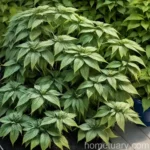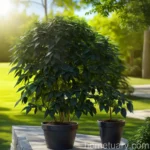Japanese Angelica Tree (Aralia elata): A Comprehensive Guide
The Japanese angelica tree, scientifically known as Aralia elata, is a stunning and versatile plant that deserves a place in every garden. This species boasts a rich cultural history and a wide range of practical uses, making it an exceptional addition to landscapes, botanical gardens, and even urban environments. In this comprehensive guide, we will delve into the various aspects of the Japanese angelica tree, from its cultural significance to its care requirements and ecological importance.
What is the Japanese Angelica Tree (Aralia elata)?
The Japanese angelica tree, or Aralia elata, is a deciduous shrub or small tree native to eastern Asia, particularly Japan, Korea, and China. It belongs to the Araliaceae family and is known for its distinctive and ornamental features, which make it a popular choice for both ornamental and practical purposes. The plant is characterized by its large, bipinnately compound leaves, showy flower clusters, and striking architectural form, making it a visually captivating addition to any landscape.
Key Takeaways – Japanese Angelica Tree (Aralia elata)
- Scientific Name: Aralia elata
- Family: Araliaceae
- Common Names: Japanese angelica tree, Devil’s Walkingstick, Korean angelica tree
- Origin: Eastern Asia (Japan, Korea, China)
- Type: Deciduous shrub or small tree
- Notable Features: Large bipinnately compound leaves, showy flower clusters, architectural form
In the following sections, we will explore the cultural significance, uses, and essential care requirements for the Japanese angelica tree, providing valuable insights for both seasoned gardeners and enthusiasts seeking to incorporate this remarkable species into their botanical repertoire.
Culture
The Japanese angelica tree holds significant cultural and historical value, particularly in its native regions of Japan, Korea, and China. It has been a part of traditional folklore and medicine, and its presence in literature and artistic representations further underscores its enduring cultural importance. The plant’s striking appearance and unique properties have inspired various cultural traditions and stories, adding to its mystique and allure.
Uses
The Japanese angelica tree serves a diverse array of practical purposes, ranging from medicinal applications to ornamental and landscape uses. Its root, bark, and other parts have been utilized in traditional herbal medicine for their purported health benefits. Furthermore, its aesthetic appeal and architectural form make it a favored choice for landscaping, botanical gardens, and urban green spaces. Additionally, the plant’s ecological significance cannot be understated, as it contributes to biodiversity and provides habitat and sustenance for various forms of wildlife.
Care Requirements
To cultivate and maintain the Japanese angelica tree successfully, it is crucial to understand and fulfill its specific care requirements. From water and sunlight needs to soil preferences and disease management, here is a detailed overview of the essential care guidelines for ensuring the optimal growth and well-being of Aralia elata.
Water
The Japanese angelica tree thrives in moist, well-drained soil, making regular watering an essential aspect of its care regimen. During the growing season, particularly in the warmer months, it is important to ensure consistent moisture levels without waterlogging the root system. Adequate hydration is critical for sustaining the plant’s overall health, foliage vigor, and flowering capacity.
Water Requirements:
– Frequency: Regular watering, especially during dry spells
– Method: Direct watering at the base to promote deep root establishment
– Consistency: Maintain moist, well-drained soil without waterlogging
Sunlight
Aralia elata exhibits a preference for partial shade to full sun, making it adaptable to a range of light conditions. While it can thrive in partially shaded areas, exposure to direct sunlight promotes robust growth, abundant flowering, and the development of its characteristic foliage. Understanding the plant’s sunlight requirements is pivotal in selecting an optimal location for its cultivation.
Sunlight Requirements:
– Ideal Exposure: Partial shade to full sun
– Benefits of Sunlight: Promotes robust growth, flowering, and foliage development
– Adaptability: Tolerant of varying light conditions, but thrives in direct sunlight
Fertilizer
Providing balanced nutrition is essential for supporting the Japanese angelica tree’s growth and vitality. A well-rounded fertilizer regimen can enhance its foliage quality, flowering potential, and overall resilience. Careful consideration of the plant’s nutrient requirements and appropriate timing for fertilization is crucial in optimizing its health and ornamental appeal.
Fertilizer Guidelines:
– Type: Balanced, slow-release fertilizer suitable for deciduous shrubs and trees
– Application: Apply fertilizer in early spring and midsummer
– Quantity: Use a measured amount as per the specific product’s instructions
Soil
Aralia elata thrives in humus-rich, well-drained soil with a slightly acidic to neutral pH range. Its root system benefits from loose, fertile soil that facilitates nutrient uptake and aeration. Understanding the plant’s soil preferences and providing an optimal growing medium is fundamental for maintaining its vigor and longevity.
Soil Requirements:
– Composition: Humus-rich, well-drained soil
– pH Range: Slightly acidic to neutral (pH 5.5–7.0)
– Structure: Loose, fertile soil for optimal root development
Pruning
Pruning is a valuable practice for shaping and managing the growth of the Japanese angelica tree. It facilitates the removal of damaged or overgrown branches, promotes air circulation within the canopy, and encourages a balanced and aesthetically pleasing form. Appropriate pruning techniques and timing are vital for maximizing the plant’s visual appeal and structural integrity.
Pruning Guidelines:
– Timing: Perform pruning during the dormant season, preferably in late winter or early spring
– Objectives: Remove dead or diseased branches, shape the plant, and manage its size
– Techniques: Utilize clean, sharp tools to make precise cuts and minimize damage
Propagation
The propagation of Aralia elata can be achieved through various methods, including seed sowing, division, and stem cuttings. Each approach offers unique advantages and challenges, allowing for flexibility in propagating new plants and expanding their presence in diverse settings. Successful propagation techniques can contribute to the plant’s conservation, horticultural application, and genetic diversity.
Propagation Methods:
– Seed Sowing: Collect and sow fresh seeds in suitable growing medium
– Division: Divide mature plants during the dormant season to create new specimens
– Stem Cuttings: Root carefully prepared cuttings in a favorable environment to establish new plants
Container Popularity
The Japanese angelica tree is well-suited for container cultivation, offering a versatile and striking addition to outdoor and indoor spaces. Its compact size, ornamental features, and adaptability to container growth make it an appealing choice for patio gardens, urban landscapes, and interior décor. Understanding the considerations for container cultivation is crucial for optimizing the plant’s performance and visual impact.
Benefits of Container Cultivation:
– Space Efficiency: Ideal for small gardens, patios, and urban settings
– Aesthetic Appeal: Attractive foliage, architectural form, and seasonal interest
– Versatility: Suitable for both outdoor and indoor environments
Common Diseases
While the Japanese angelica tree is generally robust, it may be susceptible to certain diseases that can affect its health and appearance. Recognizing the symptoms and implementing preventive measures are essential for safeguarding the plant from potential diseases and ensuring its long-term well-being.
Common Diseases:
– Powdery Mildew: White, powdery growth on foliage, particularly during humid conditions
– Leaf Spot: Circular, discolored lesions on leaves, often caused by fungal pathogens
– Root Rot: Wilting, yellowing foliage, and overall decline due to waterlogged soil
Disease Diagnosis
Timely and accurate diagnosis of plant diseases is crucial for implementing effective control measures and preserving the health of the Japanese angelica tree. By recognizing the symptoms, causal agents, and environmental factors contributing to diseases, gardeners and plant enthusiasts can take proactive steps to mitigate the impact and promote recovery.
Diagnostic Approaches:
– Visual Inspection: Identification of characteristic symptoms on foliage, stems, and roots
– Laboratory Analysis: Submit samples for pathogen testing and disease confirmation if necessary
– Environmental Evaluation: Assess factors such as moisture levels, air circulation, and soil conditions
Common Pests
The Japanese angelica tree may face potential threats from various insect pests, which can impact its growth, foliage quality, and overall vigor. Vigilance and proactive management are essential for addressing pest issues and preventing significant damage to the plant.
Common Pests:
– Aphids: Small, sap-sucking insects that colonize new growth and tender plant parts
– Scale Insects: Hard or soft-bodied pests that attach to stems and foliage, often resembling small bumps
Botanist’s Tips
1. Environmental Considerations:
- Climate Preference: The Japanese angelica tree thrives in temperate to subtropical climates and is adaptable to varying environmental conditions.
- Soil Requirements: Provide well-drained, fertile soil with moderate moisture retention for optimal growth and health.
2. Plant Maintenance:
- Regular Inspection: Monitor the plant for signs of disease, pest infestations, or nutrient deficiencies and take appropriate action.
- Pruning Strategy: Utilize strategic pruning to shape the plant, enhance its form, and manage its size effectively.
3. Conservation and Propagation:
- Seed Collection: Gather seeds responsibly from mature plants to contribute to the conservation of genetic diversity.
- Propagation Techniques: Experiment with different propagation methods to expand the plant’s presence and contribute to horticultural diversity.
Fun Facts
The Japanese angelica tree is not only a visually captivating species, but it also possesses intriguing qualities and historical significance. Here are some fun and fascinating facts about Aralia elata:
- Cultural Symbolism: In Japanese folklore, Aralia elata is associated with protective and warding properties, often planted near homes for its purported spiritual significance.
- Wildlife Attraction: The plant’s flowers and berries provide food for pollinators and birds, contributing to local ecological systems and biodiversity.
- Ornamental Usage: In addition to its traditional applications, the plant has gained popularity as a striking ornamental addition in contemporary gardens and landscapes.
Links to External Resources
To further your knowledge and exploration of the Japanese angelica tree, consider the following external resources:
- Aralia elata Growth Habits
- Japanese Angelica Tree Appearance
- Aralia elata Care Tips
- Japanese Angelica Tree Pruning
- Aralia elata Diseases and Pests
- Japanese Angelica Tree Propagation
- Aralia elata Landscape Uses
- Japanese Angelica Tree Planting Guide
- Aralia elata Medicinal Benefits
- Japanese Angelica Tree Foliage Color
Conclusion
The Japanese angelica tree (Aralia elata) stands as a captivating and versatile plant species, celebrated for its ornamental qualities, cultural significance, and practical applications. By understanding its cultural heritage, care requirements, and ecological value, individuals and horticultural enthusiasts can appreciate and integrate this remarkable species into diverse settings, from traditional gardens to modern urban landscapes. With the insights and guidelines provided in this comprehensive guide, we hope to inspire a deeper appreciation for the Japanese angelica tree and encourage its sustainable cultivation and conservation for future generations to enjoy.
Aralia elata represents a fascinating subject area for plant enthusiasts and gardeners alike, blending cultural heritage with practical applications. The comprehensive overview provided in this blog post aims to serve as a valuable resource for individuals interested in learning about and cultivating this remarkable species. From its storied cultural significance to its essential care requirements and ecological benefits, the Japanese angelica tree embodies a rich tapestry of botanical intrigue and practical utility.















